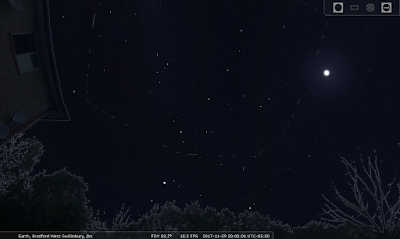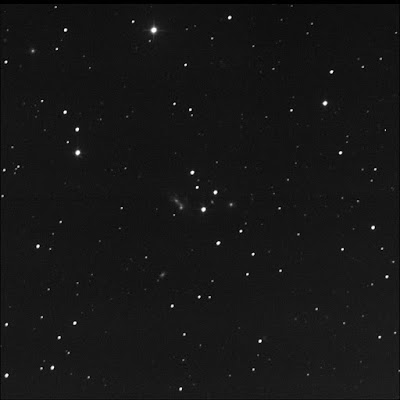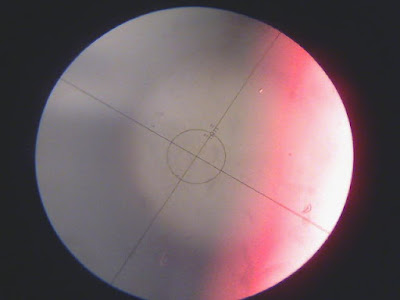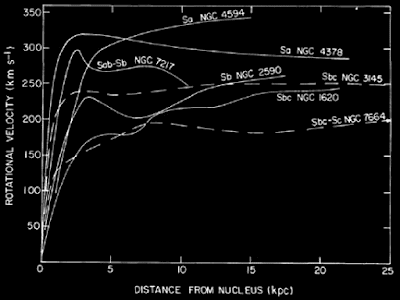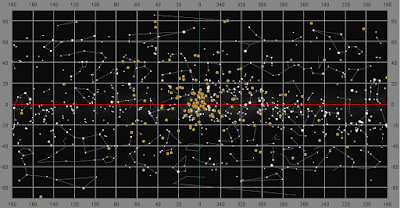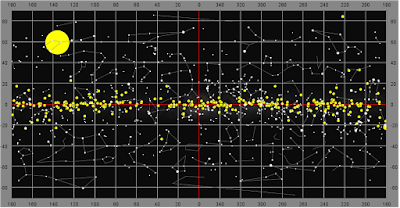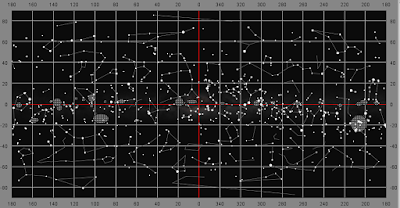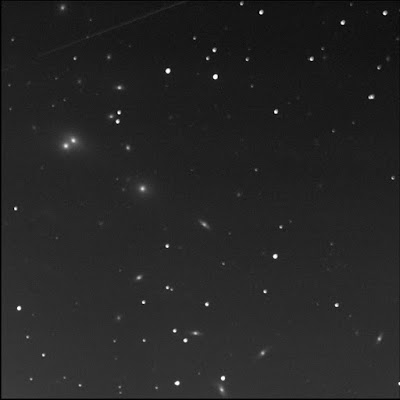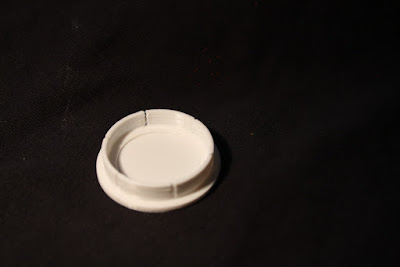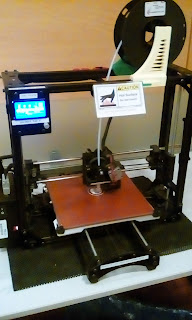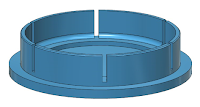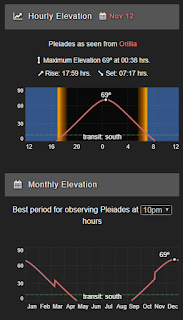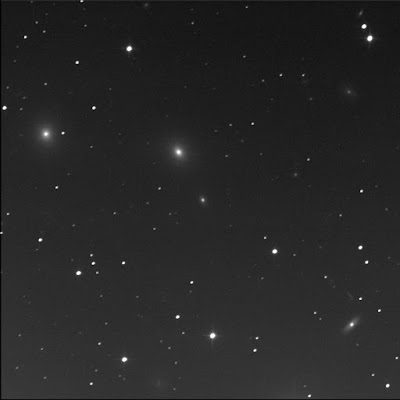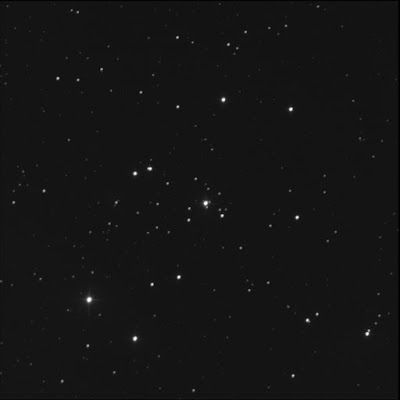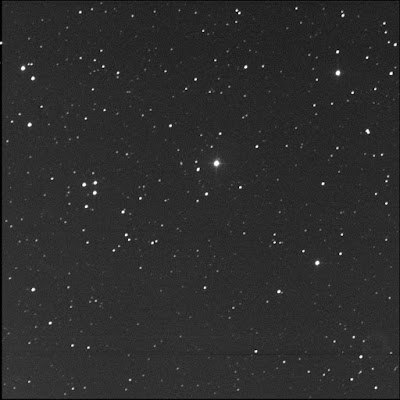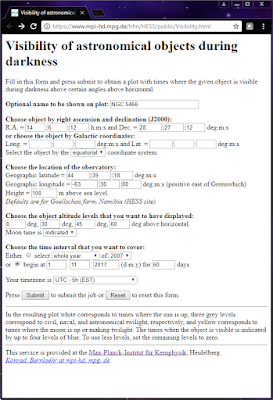Thursday, November 30, 2017
next SpaceX launch on used booster
Read that NASA is going to launch on a previously-flown SpaceX booster. It's all coming together. The commercial entrants in the space flight business are helping their customers, including space agencies, get to space cheaper and faster. The full article at SpaceFlightNow says that Elon Musk's company will send a cargo ship to the International Space Station on a recycled Falcon 9 stage 1 rocket on Fri 8 Dec, mission CRS-13. The booster first flew on CRS-11 in Jun.
assessed the damage
Tore down ETX to assess the damage.
The right fork arm was completely broken. It tore away from optical tube assembly and the base! The three arm mount points were broken. Short fasteners normally screw into these posts to hold the arm to the base. Two were fully snapped off. One was broken at the mid-point but I suspected the screw wouldn't reach it. The OTA attaches to the arm by two bolts. One mount hole was destroyed with the bottom ripped out. One OTA machine screw was missing. Was it in the grass; was it ever there?
The left fork arm was attached to the base and felt secure. [ed: I discovered later that one screw mount was damaged, probably in the crash.] The OTA mounting plate was damaged with one corner cracked. It disintegrated when I removed the bolt.
There was no interior damage, that is, nothing wrong with the motors and gears. Guts were good!
Happily, there was nothing wrong with the telescope proper. The expensive bit.
Sheesh.
The right fork arm was completely broken. It tore away from optical tube assembly and the base! The three arm mount points were broken. Short fasteners normally screw into these posts to hold the arm to the base. Two were fully snapped off. One was broken at the mid-point but I suspected the screw wouldn't reach it. The OTA attaches to the arm by two bolts. One mount hole was destroyed with the bottom ripped out. One OTA machine screw was missing. Was it in the grass; was it ever there?
The left fork arm was attached to the base and felt secure. [ed: I discovered later that one screw mount was damaged, probably in the crash.] The OTA mounting plate was damaged with one corner cracked. It disintegrated when I removed the bolt.
There was no interior damage, that is, nothing wrong with the motors and gears. Guts were good!
Happily, there was nothing wrong with the telescope proper. The expensive bit.
Sheesh.
now the add-ins were not showing
Told Hristo I had not extracted the debug logs yet. But I verified I had the latest versions of Lunar Occ (1.1.0) and OcculTools (1.4.0). In fact, I had the correct versions installed before he sent the links. Shared the results of a quick experiment. I had renamed the two add-in DLLs and launched OW. They disappeared from the Add-ins menu, as expected. Then I installed the latest versions of the add-ins and re-launched OW. The Add-ins menu did not show them! I asked why would it not automatically detect them.
Labels:
DIY,
double stars,
Moon,
occultation,
software
only one X in 2018
Generated my Lunar X report for 2018. Doesn't look good.
Only one chance in the new year... January. That's it. Well. Maybe two. The December will start in daylight.
Only one chance in the new year... January. That's it. Well. Maybe two. The December will start in daylight.
more ideas on OW
Hristo replied to my last update in the Occult Watcher Yahoo!Group. He thought there might be a problem with the AutoUpdate. He noted the latest version of each add-in: Lunar Occ 1.1.0; Occult Tools 1.4.0. He asked me to use MS DebugView and send him the logs. He recommended I download the latest versions of the add-ins. The links he provided were the same as the ones on the OW add-ins web page.
Labels:
double stars,
Moon,
occultation,
software
tried V378 faster (Halifax)
Diminished returns. I asked the Burke-Gaffney Observatory to shoot M47 again but with a 1 second exposure. In hopes of split V378 A and B. They are about 5 arc-seconds apart. But B is magnitude 12. I don't see it.
Luminance only, 1 second subexposures, 20 stacked shots. FITS Liberator, Paint.NET. North is up; east is left.
First shot on 20 Dec '16.
Then again on 12 Nov '17.
Luminance only, 1 second subexposures, 20 stacked shots. FITS Liberator, Paint.NET. North is up; east is left.
First shot on 20 Dec '16.
Then again on 12 Nov '17.
Labels:
Apogee,
double stars,
Messier,
open clusters,
photography
asked for help on OW-public
Posted on the Occult Watcher Yahoo!Group regarding the trouble I was having getting the add-ins to work.
Shared that I had already tried many things. I had downloaded and installed Occult Watcher 4.5.0.2. I had downloaded and installed Lunar Occ add-in along with the Occult Tools add-in. I had downloaded and installed Occult 4.5.0.2. I noted the folder locations used.
Relayed the errors I was encountering.
When I tried to configure Occult Tools, it reported:
This addin requires Occult 4.5.0.0 or later verssion [SIC]
I received a similar error when I tried to configure Lunar Occ.
This addin requires Occult 4.0.8.15 or later verssion
I didn't understand why I was getting these errors when I have the latest Occult installed.
§
Hristo replied. He asked me to check the supplied path in the add-in location fields. Perhaps the space was not a space. That was a little bit of grasping at straws. He asked me to verify the Occult.exe version. Perhaps he missed this in my post. He wondered if there was a bug but he was certain he had tested this. Anyhoo, I obliged.
§
I said that whether I pointed to the folder location or typed it, the error was thrown.
I noted the version of the Lun Occ add-in as 1.0.3.
I confirmed the Occult.exe version (as noted in the first message).
§
Hristo asked me to rename the folder for Occult.exe to remove the space. I had already thought of this and done it.
§
I said that I noticed previously used configuration settings seemed to be re-appearing when the software was reinstalled. I asked if this data was kept in the Windows registry. I wondered if it was kludging things and should be removed or reset.
Shared that I had already tried many things. I had downloaded and installed Occult Watcher 4.5.0.2. I had downloaded and installed Lunar Occ add-in along with the Occult Tools add-in. I had downloaded and installed Occult 4.5.0.2. I noted the folder locations used.
Relayed the errors I was encountering.
When I tried to configure Occult Tools, it reported:
This addin requires Occult 4.5.0.0 or later verssion [SIC]
I received a similar error when I tried to configure Lunar Occ.
This addin requires Occult 4.0.8.15 or later verssion
I didn't understand why I was getting these errors when I have the latest Occult installed.
§
Hristo replied. He asked me to check the supplied path in the add-in location fields. Perhaps the space was not a space. That was a little bit of grasping at straws. He asked me to verify the Occult.exe version. Perhaps he missed this in my post. He wondered if there was a bug but he was certain he had tested this. Anyhoo, I obliged.
§
I said that whether I pointed to the folder location or typed it, the error was thrown.
I noted the version of the Lun Occ add-in as 1.0.3.
I confirmed the Occult.exe version (as noted in the first message).
§
Hristo asked me to rename the folder for Occult.exe to remove the space. I had already thought of this and done it.
§
I said that I noticed previously used configuration settings seemed to be re-appearing when the software was reinstalled. I asked if this data was kept in the Windows registry. I wondered if it was kludging things and should be removed or reset.
Labels:
DIY,
double stars,
Moon,
occultation,
software
Wednesday, November 29, 2017
maybe should not have
That was a comedy of errors...
Dropped the ETX 'scope.
Could not find a proper bracket for big binos.
Mounted alternate bracket backwards on tripod.
Initially chose targets nearly straight up.
Didn't dress properly so felt rather cold.
And the binoculars dewed up.
Was the Universe telling me something?
Dropped the ETX 'scope.
Could not find a proper bracket for big binos.
Mounted alternate bracket backwards on tripod.
Initially chose targets nearly straight up.
Didn't dress properly so felt rather cold.
And the binoculars dewed up.
Was the Universe telling me something?
Labels:
binoculars,
dew removal,
error,
Meade,
Orion,
planning,
weather
at least I saw a couple (Bradford)
Set up in the backyard. In the end, big binoculars on the big tripod. Big winter coat.
The 8:00 PM slot said: cloud cover, 10, clear; transparency, 3, average; seeing, 3/5, average, with the Moon altitude at 46.5.
Good To Stargaze showed low wind, high humidity, no clouds, good seeing and transparency. The temperature was to plummet.
Considered V402 in Lacerta but it was almost overhead.
6:40 PM. Meteor southbound, out of the corner of my eye.
6:43. Was going for V640 Cassiopeiae. At β (beta) Cas I noted lots of tiny delicate doubles to the south. Some at 90 degrees to one another. All similar brightness and similar separations.
[ed: SkyTools 3 Pro shows doubles and multi-star systems here. In the magnitude 7 and 8 range. The nearest is not a double proper but two close stars, including HD 627 and HD 594. The "middle" pair is the multi-star system HD 570 with the B component at 123.3 seconds-of-arc distance. The third set is a wide pair, V742, with a separation of 124.9". Cool!]
Could not split V640.
6:46. I checked ST3P for the details and wondered why it was on the list. This is a very tight pair at 1.6". That would be challenging at the best of times in a large instrument. It is a fast-mover at just over 100 years.
It was nearly straight up. A neck-breaker. That made it even more challenging as I could not view it comfortably.
6:59. Could not split HD 13247 in Triangulum. Wider (at 11") but dimmer (mag 8 and 9).
7:04. Thought I was splitting 7 Persei. There seemed to be a faint companion at the 11 o'clock position.
On subsequent viewing, I started to doubt it.
ST3P said the B star was mag 11.5. D and E were brighter...
I wondered about the mag limit of the Orion Little Giant II binoculars. Perhaps 11?
7:11. On 15 Tri. Got 'em! I was happy. Wide pair, 141.5". Mag 5½ and 7 stars.
Easy target in bins.
Pale orange. B is aquamarine.
West was up for me. The colourful pair was on the end of a large inverted T-shape of stars, with HR 738.
7:18. No joy for ζ (zeta) Per. While the primary was bright, all the companions were very dim.
My legs were cold.
Considered candidates that weren't so high. Went back to the main DS list...
Went inside to warm up. Said hello to Bree. Added some more targets to my observing list.
My feet were cold in my regular boots. Weird. Put on the -100 set.
7:40. Found dew oculars of the binos, sadly, while the sky-facing objectives were fine. Was it my breath or body heat?. Brought a chemical hand warmer to clear the fog.
Viewed phi in Auriga. Nestled in a big flattened triangle of stars, including HR 1795.
Rather cool system. Spotted the B, C, and D stars. They make a triad. B is to the east. C is to the south-east. D was the brightest to the north. C kept fading from view. Sometimes it would pop; sometimes I couldn't see it with averted vision. Very nice. Lovely field.
I wondered about targets in Vulpecula and Sagitta. Wandered to the south-east corner of the yard to take in the sky. Then I felt my mojo go away. Done. Headed back to the gear just as headlights appeared in the driveway...
Pulled some weather data. As of 8:29 PM at Environment Canada observed at the Toronto Buttonville Municipal Airport. Current Conditions 0°C. Condition: Clear. Pressure: 102.8 kPa. Temperature: -0.4°C. Dew point: -4.4°C. Humidity: 74%. Wind: N 5 km/h. Wind Chill: -2. The detailed forecast, issued at 3:30 PM for tonight said, "A few clouds. Wind northwest 20 km/h becoming light early this evening. Low minus 6."
So, not a complete write-off. Got a couple more checked off the DS candidate list. That's good.
The 8:00 PM slot said: cloud cover, 10, clear; transparency, 3, average; seeing, 3/5, average, with the Moon altitude at 46.5.
Good To Stargaze showed low wind, high humidity, no clouds, good seeing and transparency. The temperature was to plummet.
Considered V402 in Lacerta but it was almost overhead.
6:40 PM. Meteor southbound, out of the corner of my eye.
6:43. Was going for V640 Cassiopeiae. At β (beta) Cas I noted lots of tiny delicate doubles to the south. Some at 90 degrees to one another. All similar brightness and similar separations.
[ed: SkyTools 3 Pro shows doubles and multi-star systems here. In the magnitude 7 and 8 range. The nearest is not a double proper but two close stars, including HD 627 and HD 594. The "middle" pair is the multi-star system HD 570 with the B component at 123.3 seconds-of-arc distance. The third set is a wide pair, V742, with a separation of 124.9". Cool!]
Could not split V640.
6:46. I checked ST3P for the details and wondered why it was on the list. This is a very tight pair at 1.6". That would be challenging at the best of times in a large instrument. It is a fast-mover at just over 100 years.
It was nearly straight up. A neck-breaker. That made it even more challenging as I could not view it comfortably.
6:59. Could not split HD 13247 in Triangulum. Wider (at 11") but dimmer (mag 8 and 9).
7:04. Thought I was splitting 7 Persei. There seemed to be a faint companion at the 11 o'clock position.
On subsequent viewing, I started to doubt it.
ST3P said the B star was mag 11.5. D and E were brighter...
I wondered about the mag limit of the Orion Little Giant II binoculars. Perhaps 11?
7:11. On 15 Tri. Got 'em! I was happy. Wide pair, 141.5". Mag 5½ and 7 stars.
Easy target in bins.
Pale orange. B is aquamarine.
West was up for me. The colourful pair was on the end of a large inverted T-shape of stars, with HR 738.
7:18. No joy for ζ (zeta) Per. While the primary was bright, all the companions were very dim.
My legs were cold.
Considered candidates that weren't so high. Went back to the main DS list...
Went inside to warm up. Said hello to Bree. Added some more targets to my observing list.
My feet were cold in my regular boots. Weird. Put on the -100 set.
7:40. Found dew oculars of the binos, sadly, while the sky-facing objectives were fine. Was it my breath or body heat?. Brought a chemical hand warmer to clear the fog.
Viewed phi in Auriga. Nestled in a big flattened triangle of stars, including HR 1795.
Rather cool system. Spotted the B, C, and D stars. They make a triad. B is to the east. C is to the south-east. D was the brightest to the north. C kept fading from view. Sometimes it would pop; sometimes I couldn't see it with averted vision. Very nice. Lovely field.
I wondered about targets in Vulpecula and Sagitta. Wandered to the south-east corner of the yard to take in the sky. Then I felt my mojo go away. Done. Headed back to the gear just as headlights appeared in the driveway...
Pulled some weather data. As of 8:29 PM at Environment Canada observed at the Toronto Buttonville Municipal Airport. Current Conditions 0°C. Condition: Clear. Pressure: 102.8 kPa. Temperature: -0.4°C. Dew point: -4.4°C. Humidity: 74%. Wind: N 5 km/h. Wind Chill: -2. The detailed forecast, issued at 3:30 PM for tonight said, "A few clouds. Wind northwest 20 km/h becoming light early this evening. Low minus 6."
So, not a complete write-off. Got a couple more checked off the DS candidate list. That's good.
Labels:
binoculars,
double stars,
meteors,
naked
Heavy delayed to January
Learned that the first run of Space X's Falcon Heavy was pushed to early 2018. Musk wanted to launch in December.
See the full article at Spaceflight Now.
Be fun to experience one of these. Never did get a chance to see a shuttle launch.
Still slated for December is the static fire test...
See the full article at Spaceflight Now.
Be fun to experience one of these. Never did get a chance to see a shuttle launch.
Still slated for December is the static fire test...
Labels:
SpaceX
reinstall the Occult apps and add-ins
Ran through the entire Occult Watcher set-up again. I deleted everything. I rebooted.
Set up Occult. It is required for the Lunar Occultation add-in. And perhaps I'll use the Occult Tools add-in as well.
Installed the app. Downloaded from the Occult page at IOTA (which referred to version 4.2.0). Used the hyperlink to download the occultinstaller.zip file. Followed the instructions for the manual set-up. Created a directory (natch, folder) on C's root. They suggested "occult 4." Unzip the files. The documentation said there would be 9 files. Hello, there's 11. That's not good. These days, with software threats, they should be precise. I created the shortcut on the desktop. I skipped the option to run as admin as I had not put the subfolder within the Program Files folder.
Configured the app. Launched Occult. It made its subfolders. I let it download the two files for resources and sites. I saw my previously used settings (including dummy SMTP mail stuff) as when I had a configured it before. I downloaded the data again. This time I included the Tycho database. I briefly tested Occult. It seemed OK.
On to Occult Watcher. Tried to follow the instructions on the OW 4.5 "publish" page. It's confusing though with the hyperlink "Download" title which refers to a file called OWsetup.msi (and that's an old version of OW, 3.9). I ignore that and downloaded the OWupdate.zip file. This seemed correct as the install version was 4.5.0.2. This time I did not create the folder under Program Files (which I had done on my first attempt). As instructed, I ran the OWupdate.exe program as the administrator.
Configured the app. It picked up my previous settings. So I changed nothing. Tried testing. The main listing generated OK. I activated the Lunar Occultations for Close Double Stars feed but it didn't seem to work. I checked the Add-ins menu. Tried to configure the Lunar and Occult Tools items. They issued errors. That an old version of Occult was installed. Huh? That didn't make sense.
Set up Occult. It is required for the Lunar Occultation add-in. And perhaps I'll use the Occult Tools add-in as well.
Installed the app. Downloaded from the Occult page at IOTA (which referred to version 4.2.0). Used the hyperlink to download the occultinstaller.zip file. Followed the instructions for the manual set-up. Created a directory (natch, folder) on C's root. They suggested "occult 4." Unzip the files. The documentation said there would be 9 files. Hello, there's 11. That's not good. These days, with software threats, they should be precise. I created the shortcut on the desktop. I skipped the option to run as admin as I had not put the subfolder within the Program Files folder.
Configured the app. Launched Occult. It made its subfolders. I let it download the two files for resources and sites. I saw my previously used settings (including dummy SMTP mail stuff) as when I had a configured it before. I downloaded the data again. This time I included the Tycho database. I briefly tested Occult. It seemed OK.
On to Occult Watcher. Tried to follow the instructions on the OW 4.5 "publish" page. It's confusing though with the hyperlink "Download" title which refers to a file called OWsetup.msi (and that's an old version of OW, 3.9). I ignore that and downloaded the OWupdate.zip file. This seemed correct as the install version was 4.5.0.2. This time I did not create the folder under Program Files (which I had done on my first attempt). As instructed, I ran the OWupdate.exe program as the administrator.
Configured the app. It picked up my previous settings. So I changed nothing. Tried testing. The main listing generated OK. I activated the Lunar Occultations for Close Double Stars feed but it didn't seem to work. I checked the Add-ins menu. Tried to configure the Lunar and Occult Tools items. They issued errors. That an old version of Occult was installed. Huh? That didn't make sense.
Labels:
double stars,
Moon,
occultation,
software
added to IOTA group
Application to the International Occultation Timing Association Yahoo!Group was approved. I have questions about the software...
§
Oops. Discovered the Occult Watcher group. And I was already in it. Thought it rang a bell.
§
Oops. Discovered the Occult Watcher group. And I was already in it. Thought it rang a bell.
Labels:
occultation,
software
Tuesday, November 28, 2017
draft reviewed
Rhonda proofed my draft article for the Journal.
Labels:
asteroids,
occultation,
RASC,
software
zoomed to the eclipse
Rhonda received her latest issue of Zoom Zoom magazine. I noted the featured article on the cover, referring to the solar eclipse.
I learned a few Mazda peeps travelled to the Tennessee with a sleek MX-5 RF. They were lucky, seeing totality between clouds.
I learned a few Mazda peeps travelled to the Tennessee with a sleek MX-5 RF. They were lucky, seeing totality between clouds.
Labels:
friends and family,
magazines,
occultation,
photography,
solar,
weather
received SN Jan/Feb 2018
Whoa! SkyNews magazine showed up. Rhonda brought it in. That seemed fast or early! Perhaps it is because the issue is featuring the astronomical highlights for 2018.
It looks like next year will feature good Mars viewing, a special lunar eclipse, and a perfect opportunity (i.e. no Moon) to view the Perseid meteor shower. Yeh!
The current issue also discusses binos and how to choose the best ones for astronomy. A new column accompanies this topic: binocular observing.
There's an article called Image-processing Basics by Mr Puerzer. Hopefully I can learn some tricks. I still struggle with this.
The Jan-Feb 2018 issue also features a solar eclipse shot by Mr Park. Congrats!
It looks like next year will feature good Mars viewing, a special lunar eclipse, and a perfect opportunity (i.e. no Moon) to view the Perseid meteor shower. Yeh!
The current issue also discusses binos and how to choose the best ones for astronomy. A new column accompanies this topic: binocular observing.
There's an article called Image-processing Basics by Mr Puerzer. Hopefully I can learn some tricks. I still struggle with this.
The Jan-Feb 2018 issue also features a solar eclipse shot by Mr Park. Congrats!
Labels:
binoculars,
magazines,
Mars,
Moon,
occultation,
photography,
planets,
planning,
RASC,
solar
applied software updates
Tried adding the Lunar Occultations add-in to Occult Watcher. It needs Occult installed but I kept misreading the notes.
Installed Occult Tools add-in to Watcher. It needed the Occult software. I finally realised what was going on.
Downloaded and installed Occult 4.5.
Tried running the configuration commands for the two add-ins but they kept reporting I needed version 4.0 or higher of Occult. Huh?
Applied the update to Occult Watcher. From 3.9 to 4.5.
All's well (I hope).
Now I can watch for lunar occultations of close double stars!
Installed Occult Tools add-in to Watcher. It needed the Occult software. I finally realised what was going on.
Downloaded and installed Occult 4.5.
Tried running the configuration commands for the two add-ins but they kept reporting I needed version 4.0 or higher of Occult. Huh?
Applied the update to Occult Watcher. From 3.9 to 4.5.
All's well (I hope).
Now I can watch for lunar occultations of close double stars!
Labels:
double stars,
Moon,
occultation,
software
tested SkyTools
Tested a special release of SkyTools 3 for Greg. We're trying to sort out some SSL issues.
Monday, November 27, 2017
huh, clear (Bradford)
Clear. For a change. They were going ahead with the City Star Party at Bayview Village Park. Saw a couple of stars as we drove north. I stood briefly by the front porch and looked at Cygnus and Lyra. Too tired to set up.
Labels:
constellations,
didn't,
naked,
weather
Saturday, November 25, 2017
DR2 will be added...
Read on the Skyhound forums that the ESA Gaia DR2 data will be integrated into the SkyTools 4 database about "year or so" after the release, which is slated for April 2018. (Missed this note, at the time...)
Labels:
double stars,
ESA,
SkyTools
true colours
I stumbled across this some time ago, don't remember when. But I wanted to share it as it is the most realistic presentation of star colour I have seen in the classic Hertzsprung-Russell Diagram.
The blues and oranges are pale. The colours are subtle. And this is how we see the colours of stars in the telescope. Or in photographs that are not oversatured.
From Bruce MacEvoy's web page Astronomical Files from Black Oak Observatory. Such as amazing resource.
The blues and oranges are pale. The colours are subtle. And this is how we see the colours of stars in the telescope. Or in photographs that are not oversatured.
From Bruce MacEvoy's web page Astronomical Files from Black Oak Observatory. Such as amazing resource.
Friday, November 24, 2017
after two weeks (Halifax)
BGO imaged the supernova SN2017eaw once again. Hanging in there. Still around magnitude 17.
Recently decreased the minimum height requirement for the Fireworks Galaxy. Image quality may begin to degrade.
Luminance only, 60 seconds subexposures, 10 stacked shots. FITS Liberator, Paint.NET. North is up; east is left.
Been a while since I've had a look. Last shot on 11 Nov.
Recently decreased the minimum height requirement for the Fireworks Galaxy. Image quality may begin to degrade.
Luminance only, 60 seconds subexposures, 10 stacked shots. FITS Liberator, Paint.NET. North is up; east is left.
Been a while since I've had a look. Last shot on 11 Nov.
Labels:
Apogee,
galaxies,
NGC,
photography,
supernovae
weirder
Reports continue to roll in our asteroid 1I aka 'Oumuamua. It is long and cylindrical, like a cigar. Measurements suggest it is 400 metres long and 40 in diameter. It is tumbling or rotating every 7 years. It is red or ruddy in colour perhaps due to cosmic ray bombardment. The article at Space.com has lots of good graphics and interesting data.
no planets in west (Brampton)
It was a very nice sky to the west, with only a few clouds, as I drove up the 410. Noticed the Moon up high when I made a quick launch. I looked for planets through furtive glances. Nope. Had hoped to see Saturn and Mercury. As the highway curved west, I had a good look. Nothing. Too late, perhaps.
was it a planet? (King City)
Saw a planet is a clear pre-dawn sky. It seemed faint. So could not have been Venus. It did not seem to have an orange or red hue. So it was likely not Mars. Was it Jupiter? Or Spica?
Thursday, November 23, 2017
imaged tiny Hickson 1 (Halifax)
I noticed in SkyTools that Hickson 1, the first object in the Hickson Compact Groups was up high. Programmed the Burke-Gaffney Observatory to image it (centring on Tycho 1734 01060 1).
Luminance only, 60 seconds subexposures, 10 stacked shots. FITS Liberator, GIMP. North is up; east is left.
The documented members in UGC 248, PGC 1625, PGC 1614, and PGC 1618.
248 is the large member to the north-east. It is touching 1625 to the south-west. Both of these look like spiral galaxies interacting, tearing each other apart. There is a very interesting bridge between them. They are east of the Tycho star.
1614 is to the west. Round. With a bright core. West of the Tycho star.
1618 is the very tiny faint round fuzzy between the others. Between Tycho 1734 01060 1 and Tycho 1734 00524 1.
South-east of the cluster proper is a bright but small almond: PGC 1628.
Labels:
Apogee,
galaxies,
photography
made a new doubles list
Made a new SkyTools list using the data from the popular Coldfield Observatory double star list. It contains 200 beautiful double and multi-star systems. I had to review the steps as I was a little rusty but I was able to import a "cleaned" list and then manually match up all the targets. Tried to put on the new SkyTools forums but it is not configured to accept STX files... Sent to Greg for vetting. He put it on the Skyhound server for download and encouraged me to promote it on the new forums. Looks like a neat list.
Labels:
double stars,
planning,
SkyTools,
software
new light kept going
While the power was out for a few hours, I noticed that the new "street" light was burning. This was the new light, at the top of the walkway, Rhonda had pointed out to me some time ago and that we walked under, triggering the sensor, on 19 Nov. It continued to operate during the outage. That made me wonder if it was battery powered and recharged with a solar panel.
§
I checked how much this light my intrude into the backyard. I can see it from certain spots unfortunately.
§
I checked how much this light my intrude into the backyard. I can see it from certain spots unfortunately.
Labels:
light pollution
Wednesday, November 22, 2017
showed spinning spirals
When the power came back on, I showed Rhonda the short video of a spiral galaxy spinning. She concurred. There's a strong impression of water running down a drain.
Wish I knew how to make a video loop on YouTube.
Explained that the galaxy on the left is spinning at an expected rate, with speeds tailing off the further we are from the centre; the right spiral portrays the observed speeds, where the outer arms are travelling faster than expected.
Wish I knew how to make a video loop on YouTube.
Explained that the galaxy on the left is spinning at an expected rate, with speeds tailing off the further we are from the centre; the right spiral portrays the observed speeds, where the outer arms are travelling faster than expected.
Labels:
cosmology,
education,
friends and family
tested web cam
Did some testing with the LogiTech 5700 web cam to see it might work as a polar scope camera.
Cut the bottom out of an old (translucent) plastic film container. Quickly attached it to the camera body (with tape) trying to keep it fairly well aligned.
Attached the USB connector to John Repeat Dance. Launched Paint and chose the capture command.
We have a picture! All right. But could not control the camera.
Installed the assembly onto the Celestron/Vixen polar axis scope. Could see the reticule pattern. Yes! Tested focusing. It worked.
The shaft was clearly too long. Cut down the film tube, removing about 1 cm. This put the camera very near the ocular. Shaft length is about 3.3 cm.
Tried Microsoft AMcap version 8.x and it worked nicely. Was able to control the output video frame size. 640x480. Manually focused the camera.
Much better.
I suspect the oblong shape is due to the misalignment.
This is looking very promising.
Strapped the polar scope to a tripod. Ready for a star test...
Cut the bottom out of an old (translucent) plastic film container. Quickly attached it to the camera body (with tape) trying to keep it fairly well aligned.
Attached the USB connector to John Repeat Dance. Launched Paint and chose the capture command.
We have a picture! All right. But could not control the camera.
Installed the assembly onto the Celestron/Vixen polar axis scope. Could see the reticule pattern. Yes! Tested focusing. It worked.
The shaft was clearly too long. Cut down the film tube, removing about 1 cm. This put the camera very near the ocular. Shaft length is about 3.3 cm.
Tried Microsoft AMcap version 8.x and it worked nicely. Was able to control the output video frame size. 640x480. Manually focused the camera.
Much better.
I suspect the oblong shape is due to the misalignment.
This is looking very promising.
Strapped the polar scope to a tripod. Ready for a star test...
Tuesday, November 21, 2017
designed ocular cover
Once again, in 123D, I made a replacement part for the Vixen Super Polaris mount. This time, I designed the polar scope cover for the rear of the mount. But I suspect it will be a big job. On TPL printers, it will likely take too long, as the part is large. I'm going to have to figure out a solution for actually producing large items.
twisted
I've made a mistake.
I have been describing galaxy rotation incorrectly for some time.
I retract the remark that galaxies are acting like rigid wheels. I would describe the motion of the stars at the outer edge of a spiral galaxy being faster than stars in the middle and faster still than the inside stars. Like spokes on a wheel.
That's wrong.
My apologies for confusion caused.
I misinterpreted information about galactic rotation.
In fact, as measured by Vera Rubins, the inner stars are moving slowly (say 50 km/s). The stars further out are moving faster (100 km/s). The stars further out are going faster still (maybe 200 to 300 km/s). And then the speed curve flattens. The stars in the middle and outer limits are going this same speed (200 to 300 km/s).
I was mistakenly continuing to ramp up the speed, the further we went out.
Given the stars in the outer spiral arms have a greater distance to travel and their speed is the same at ones in the middle, they fall behind!
This consequently explains something for me: the twisting or torquing effect. Which I could not resolve with the rigid disc approach.
All this revealed itself to me as Rhonda and I talked about types of objects in the galaxy, where they were located, how they contributed to the formation of the galaxy, and so on.
Wow.
I have been describing galaxy rotation incorrectly for some time.
I retract the remark that galaxies are acting like rigid wheels. I would describe the motion of the stars at the outer edge of a spiral galaxy being faster than stars in the middle and faster still than the inside stars. Like spokes on a wheel.
That's wrong.
My apologies for confusion caused.
I misinterpreted information about galactic rotation.
In fact, as measured by Vera Rubins, the inner stars are moving slowly (say 50 km/s). The stars further out are moving faster (100 km/s). The stars further out are going faster still (maybe 200 to 300 km/s). And then the speed curve flattens. The stars in the middle and outer limits are going this same speed (200 to 300 km/s).
I was mistakenly continuing to ramp up the speed, the further we went out.
Given the stars in the outer spiral arms have a greater distance to travel and their speed is the same at ones in the middle, they fall behind!
This consequently explains something for me: the twisting or torquing effect. Which I could not resolve with the rigid disc approach.
All this revealed itself to me as Rhonda and I talked about types of objects in the galaxy, where they were located, how they contributed to the formation of the galaxy, and so on.
Wow.
Labels:
education,
error,
friends and family,
science
Monday, November 20, 2017
the view from 63
Rhonda asked me if our solar system plane (the ecliptic) was at the same angle as the plane of the galaxy. Nope. I knew it wasn't. But I had to look it up.
63 degrees.
Which makes sense! When you factor in the tilt of the Earth to the ecliptic, that puts the galaxy at nearly 90. That's why are certain times of the year, the Milky Way goes straight overhead.
I also said that for all other systems, it would be random. Every exosolar system would be different.
63 degrees.
Which makes sense! When you factor in the tilt of the Earth to the ecliptic, that puts the galaxy at nearly 90. That's why are certain times of the year, the Milky Way goes straight overhead.
I also said that for all other systems, it would be random. Every exosolar system would be different.
types by galactic view
Ron's talk at last week's meeting was intriguing to Rhonda. But I offered to present the types of celestial objects against a galactic oriented map as opposed to what he did, showing them in maps that followed the equatorial grid (which is an extension of the Earth's terrestrial grid). The sinusoidal line of the galaxy threw her. It just makes sense to me that we take a view most like how we see the galaxy when we look up.
I recalled that the old application Where Is M13? supported a "Sky View" cylindrical projection chart with the plane of our home galaxy flat, along the horizontal. Fired it up.
The horizontal line in the middle, at 0 degrees, shows the plane of the galaxy and alludes to the location of the main disc and the Milky Way's spiral arms.
The vertical line indicates where the centre of the galaxy is, the galactic core, and the suspected bar of our spiral.
Above is the built-in "all globular clusters" preset filter. You can see the orange circles are buzzing around the hub of the galaxy with some well above and below the plane of the Milky Way. They are old structures, perhaps important in the formation of a spiral galaxy.
I made a custom filter for the "diffuse nebulae" to show the dust and gas that may be the fuel for new star systems. The green squares follow along the arms of the galaxy. There is a big void around Aquila.
Chose the built-in preset for "all open clusters." It is very clear how tight they are to the arms of the galaxy. Note the obvious gap around Aquila. The big yellow disc is Collinder 285 aka the Ursa Major Moving Group. I believe our Sun is considered a member.
Again, I made a custom filter. This one shows the planetary nebulae. Not surprisingly, the blue marks are fairly in-line with the arms. The ones above and below are likely close to us.
I found an interesting filter, the "OB associations." Ron did not address these. These are regions of hot, young stars, living life fast. They tend to go out in spectacular fashion, as supernovae, starting the whole cycle again. The stippled patterns, you can see, are in the arms. And all around us. Except in Aquila.
I recalled that the old application Where Is M13? supported a "Sky View" cylindrical projection chart with the plane of our home galaxy flat, along the horizontal. Fired it up.
The horizontal line in the middle, at 0 degrees, shows the plane of the galaxy and alludes to the location of the main disc and the Milky Way's spiral arms.
The vertical line indicates where the centre of the galaxy is, the galactic core, and the suspected bar of our spiral.
Above is the built-in "all globular clusters" preset filter. You can see the orange circles are buzzing around the hub of the galaxy with some well above and below the plane of the Milky Way. They are old structures, perhaps important in the formation of a spiral galaxy.
I made a custom filter for the "diffuse nebulae" to show the dust and gas that may be the fuel for new star systems. The green squares follow along the arms of the galaxy. There is a big void around Aquila.
Chose the built-in preset for "all open clusters." It is very clear how tight they are to the arms of the galaxy. Note the obvious gap around Aquila. The big yellow disc is Collinder 285 aka the Ursa Major Moving Group. I believe our Sun is considered a member.
Again, I made a custom filter. This one shows the planetary nebulae. Not surprisingly, the blue marks are fairly in-line with the arms. The ones above and below are likely close to us.
I found an interesting filter, the "OB associations." Ron did not address these. These are regions of hot, young stars, living life fast. They tend to go out in spectacular fashion, as supernovae, starting the whole cycle again. The stippled patterns, you can see, are in the arms. And all around us. Except in Aquila.
Minkowski's Object, briefly (Halifax)
The BGO reported a partial observation. Sounds like it was able to squeeze in a few images before clouds rolled in. Not much better than the run on 14 Oct.
I had requested NGC 541 in Cetus. A galaxy within a group that appears to be known as Minkowski's Object.
Luminance only, 60 seconds subexposures, 10 stacked shots. FITS Liberator, GIMP. North is up; east is left.
Two of the colour channels were not gathered. There's a satellite in this image. There's a bad gradient. But I don't really care. I just imaged this region for fun.
NGC 541 is the oval fuzzy, with the bright core, left of centre. aka Arp 133.
I had requested NGC 541 in Cetus. A galaxy within a group that appears to be known as Minkowski's Object.
Luminance only, 60 seconds subexposures, 10 stacked shots. FITS Liberator, GIMP. North is up; east is left.
Two of the colour channels were not gathered. There's a satellite in this image. There's a bad gradient. But I don't really care. I just imaged this region for fun.
NGC 541 is the oval fuzzy, with the bright core, left of centre. aka Arp 133.
North-north-west of 541 is a tiny round lint ball: LEDA 1121627.
Right or west of 1121627 is another tiny faint round fuzzy: LEDA 1121698.
LEDA 1120269 is due west of 541, quite a distance away. Also tiny and round and faint.
Between 541 and 1120269 is LEDA 73954. It is a bit larger and brighter than the LEDA.
South-west of 541 is an edge-on galaxy. Doesn't look like a classic spiral. SkyTools 3 Pro says NGC 535 is a lenticular.
Much further, near the bottom-right of the frame, is another object that looks identical to 535: MCG 0-4-121. It's rotated 90 degrees.
A bit to the south of these is a larger lenticular: MCG 0-4-129.
East of 0-4-129 is UGC 996. It looks similar albeit a bit smaller. Oriented east-west.
South of these two, between them, is a slightly larger spiral. NGC 538.
Due south of 541 is an almond shape with a bright core: UGC 1003.
South-east of 1003 is a round fuzzy. This is PGC 5306.
LEDA 1119267 is close to 541, to the south-east. It is very faint.
Due east of 541 is a tiny oval. LEDA 86298.
North-east of 541 is the pair of large galaxies, NGC 545 (north) and NGC 547. Together they are Arp 308. They look like classic elliptical galaxies. Bright!
North-east of these two is a small oval shape: LEDA 169816.
East of the twin stars is MCG 0-4-140. A small elongated fuzzy with a bright centre.
North of the twins is a bright round ball of light: NGC 543.
Wow. Lots happening in this area.
Labels:
Apogee,
Arp,
galaxies,
NGC,
photography
updated TSTM video
Andrew published the final version of The Sky This Month video presentation which I delivered on Wed 15 Nov.
This version has my updated slide elements.
This version has my updated slide elements.
Saturday, November 18, 2017
checking visibility part 5
That was serendipitous.
I was looking for star charts which presented the Milky Way galaxy "flat" or a chart that was oriented in the galactic perspective. Found a cool map.
When I revisited the page (called Commentary on Star Atlas in Galactic Perspective) and read the entire article (with references back to the Apollo missions), I stumbled across his hand-drawn Local Meridian Finder figure. Wow!
This is very useful as a quick and easy low bandwidth tool for predicting visibility. For example, the graphic says that on 20 Nov at midnight, objects between RA 3 and 5 will be well placed.
Shared on the RASC forum.
[ed. Grahic by Robert Fritzius used with permission. Colour-inverted by Blake.]
I was looking for star charts which presented the Milky Way galaxy "flat" or a chart that was oriented in the galactic perspective. Found a cool map.
When I revisited the page (called Commentary on Star Atlas in Galactic Perspective) and read the entire article (with references back to the Apollo missions), I stumbled across his hand-drawn Local Meridian Finder figure. Wow!
This is very useful as a quick and easy low bandwidth tool for predicting visibility. For example, the graphic says that on 20 Nov at midnight, objects between RA 3 and 5 will be well placed.
Shared on the RASC forum.
[ed. Grahic by Robert Fritzius used with permission. Colour-inverted by Blake.]
Labels:
charts and atlases,
education,
planning,
RASC
Friday, November 17, 2017
shared flattened galaxy
Sent a link to Rhonda. A "flattened" map of the Milky Way galaxy. It presents our galaxy view with little distortion, which is rather helpful I think when trying to understand where things are.
She liked it a lot.
Chart from the Shade Tree Physics web site by Robert Fritzius on a page called Commentary on Star Atlas in Galactic Perspective. Used with permission.
She liked it a lot.
Chart from the Shade Tree Physics web site by Robert Fritzius on a page called Commentary on Star Atlas in Galactic Perspective. Used with permission.
Labels:
charts and atlases,
friends and family,
Milky Way,
science
Arecibo continues scanning
Read an article at Astronomy Now. I was happy to learn that the Arecibo Observatory will keep scanning the skies. It escaped significant damage from Hurricane Maria. And now the National Science Foundation is planning to continue its support of the facility.
Labels:
science
Thursday, November 16, 2017
checking visibility part 4
Chris jumped into the "best day to observe" thread. He said:
This gets it near the meridian at midnight.
What a cool trick.
§
Not knowing the sky, in my head, in terms of celestial coordinates, I would still have to use software. And if you fire up Stellarium to do all this, then, well... you can just go to the object and figure it out that way... If Nick is after a calculation he can do in his head or do on a scrap of paper, I'm not sure it is possible now.
Ed has been alluding to this in a way in his comments that the "best night" is also impacted by other factors. The big one, for me, is moonlight. If you're going for dim fuzzies, you want maximum elevation on dark nights. The elevation is pretty easy to get. But then the lunar cycle comes into play...
You could also add (or subtract) twelve hours to (from) the desired object's R.A. and then adjust the date to place the sun at the calculated R.A... Then revert to night time and adjust the hour to put the object on the meridian.Ah. Is it that simple? By adding (or subtracting) 12 hours against the target RA, it puts the Sun opposite the target. And then the target will be high in the night sky.
This gets it near the meridian at midnight.
What a cool trick.
§
Not knowing the sky, in my head, in terms of celestial coordinates, I would still have to use software. And if you fire up Stellarium to do all this, then, well... you can just go to the object and figure it out that way... If Nick is after a calculation he can do in his head or do on a scrap of paper, I'm not sure it is possible now.
Ed has been alluding to this in a way in his comments that the "best night" is also impacted by other factors. The big one, for me, is moonlight. If you're going for dim fuzzies, you want maximum elevation on dark nights. The elevation is pretty easy to get. But then the lunar cycle comes into play...
fits like a glove
Grabbed the Vixen Super Polaris mount. Installed the new cap. It fit! Amazing.
When I bought this mount on consignment many years ago, at the time, I did not know it was missing many pieces. Like the fore and aft polar axis scope caps.
Slowly, I'm getting it back to its original state.
When I bought this mount on consignment many years ago, at the time, I did not know it was missing many pieces. Like the fore and aft polar axis scope caps.
Slowly, I'm getting it back to its original state.
Wednesday, November 15, 2017
what about flat?
Rhonda and I chatted on the way home. She enjoyed the evening. Learned lots from the presenters. She particularly liked Ron's talk on the Milky Way and spiral arms of galaxies. I wondered about viewing the charts though a different way, with the galaxy plane flat—I think it might be more powerful that way.
Labels:
education,
friends and family,
fun,
galaxies,
RASC
a new part
It freaks me out a little bit. This little plastic object did not exist in the world a few hours ago. The cap I made for my Vixen SP mount I drew in computer 3D software, copied to a memory card, converted to print code, loaded into a 3D printer, which extruded white PLA in the appropriate pattern.
I showed my new prized possession to Peter H. He said they too use 3-dimensional printing, for their electronic equipment projects. Showed Rhonda. She was excited for me. Showed the gang at dinner. I thank Chris V for spotting it all the table as we were leaving. That would have been heart-breaking if I had immediately lost it.
I showed my new prized possession to Peter H. He said they too use 3-dimensional printing, for their electronic equipment projects. Showed Rhonda. She was excited for me. Showed the gang at dinner. I thank Chris V for spotting it all the table as we were leaving. That would have been heart-breaking if I had immediately lost it.
go for your certificate
For the first time, in my TSTM presentation, I promoted observing certificate programmes. I deliberately included a number of targets that are in different campaigns. For example, the planets, a comet, features of the Moon, are on the Explore the Universe. There are targets included in RASC Finest NGCs. I referred to a few Messier objects. And there are a couple of Herschel 400 targets. From beginner to advanced.
delivered TSTM
Delivered The Sky This Month presentation at the Ontario Science Centre for the RASC Toronto Centre.
The time frame reported on runs from 15 Nov to 13 Dec. The meeting was streamed live; final video will follow soon. My presentation notes were used to form the web page article. As usual, it includes a downloadable month-at-a-glance calendar. There are observing list files available for SkySafari and SkyTools. New, this time, I made an Excel file.
Wore my red LED name badge programmed as "Blake. Space Tour Guide." People liked that.
Wore my eclipse t-shirt too.
§
View the captured rough-cut video on YouTube. Sheesh, I look funny. This includes all the speakers in the evening. About 2 hours in length.
Updated video online. Just the TSTM. About 30 minutes.
§
Accolades from various members. No, thank you.
The time frame reported on runs from 15 Nov to 13 Dec. The meeting was streamed live; final video will follow soon. My presentation notes were used to form the web page article. As usual, it includes a downloadable month-at-a-glance calendar. There are observing list files available for SkySafari and SkyTools. New, this time, I made an Excel file.
Wore my red LED name badge programmed as "Blake. Space Tour Guide." People liked that.
Wore my eclipse t-shirt too.
§
View the captured rough-cut video on YouTube. Sheesh, I look funny. This includes all the speakers in the evening. About 2 hours in length.
Updated video online. Just the TSTM. About 30 minutes.
§
Accolades from various members. No, thank you.
A/2017 U1 renamed 1I
The International Astronomical Union has reclassified the interstellar asteroid A/2017 U1 to 1I. The digit one indicates it is the first object under this category. The letter i represents the interstellar classification.
They also applied a given name, 'Oumuamua. This is a Hawaiian term meaning "scout." The first element ʻOu means "reach out for" and mua, repeated for emphasis, means the "first, in advance of."
They also applied a given name, 'Oumuamua. This is a Hawaiian term meaning "scout." The first element ʻOu means "reach out for" and mua, repeated for emphasis, means the "first, in advance of."
checked out LXD55
Inspected a telescope a member wishes to donate. A 8-inch f/8 Meade LXD55 with its equatorial mount and accessories and custom case. I don't think I've ever seen this particular one before, a Schmidt-Newtonian.
Labels:
equipment,
friends and family,
Meade,
RASC
made cap
Completed my first ever 3D print job. Thanks to the Toronto Public Library staff at the Reference Library for their support and assistance. Produced the telescope part I had designed last night.
We struggled with a finicky Ultimaker 2 printer and later switched to their fast LulzBot.
Made my polar scope outboard cover for the Vixen Super Polaris mount. The 4-gram piece was completed in about 12 minutes.
Printed in white PLA. The original Vixen part was black. OK with me the bright colour. It will be easier to see if (er, when) dropped at night.
A little boy with his mom looked in as I started my print job. She asked him to ask me what I was doing. I told him I was making a cap for my telescope because I had lost the original part. His mom liked that story. Learned he has a telescope too. And if he loses any parts, he can make a new one.
We struggled with a finicky Ultimaker 2 printer and later switched to their fast LulzBot.
Made my polar scope outboard cover for the Vixen Super Polaris mount. The 4-gram piece was completed in about 12 minutes.
Printed in white PLA. The original Vixen part was black. OK with me the bright colour. It will be easier to see if (er, when) dropped at night.
A little boy with his mom looked in as I started my print job. She asked him to ask me what I was doing. I told him I was making a cap for my telescope because I had lost the original part. His mom liked that story. Learned he has a telescope too. And if he loses any parts, he can make a new one.
Tuesday, November 14, 2017
quickly designed cap
As I planned a trip to the Toronto Public Library, I considered what I might produce with a 3D printer. Didn't think I should proceed with making the replacement latch for Mom's old cassette deck. The iOptron motor cover I had designed back in March 2016 was not an option. Didn't need a spacer for the C8 and Williams Optics focuser. I wasn't prepared to design (or refine) the new deep red flashlight case. I checked Evernote for ideas. Ah. A cap for the Vixen Super Polaris mount to cover the sky-facing port of the polar axis scope. A nice little small project...
Quickly dashed off the design in Autodesk 123D. Saved the STL file to a SD card.
Quickly dashed off the design in Autodesk 123D. Saved the STL file to a SD card.
plotted distant moons
As I prepared for my TSTM presentation, I wondered about the moons of Uranus. I wondered if it was possible to view them in a graphical way, in a sinusoidal chart like what is shown in the RASC Observer's Handbook, for the moons of Jupiter. Initially, I considered that I could make such a chart myself if I could get the periodic data. On a whim, I conducted a search on the interwebs, and was pleasantly surprised to find the Uranus Moon Tracker tool. Perfect! Pretty easy to use. I made a chart for my TSTM article showing Oberon, Titania, and Ariel. Verified that 10 December will be a particularly good evening.
checking visibility part 3
We heard from Nick!
He thanked everyone for their responses.
He shared he's been using many of the tools we've already referred him too. And he indicated he's using the "intro" version of SkyTools. I think he means the Starter edition.
He also told us about objects he likes looking at. Sue French's Asterisms list, Palomar Globulars, Harvard objects, Abell objects, Jones 1, Klemora 4, Basel 1, Jonckheere 900, ESO galaxies, some red variable stars, etc. Whoa. Some of those are faint.
SkyTools Starter edition only includes 4 million stars, down to magnitude 12.5.
Nick said that DSO Browser was the best tool for him but doesn't allow the adding of objects. He also said he cannot search by RA & Dec. Oh.
He asked again, "What is 'this easy calculation?'"
He thanked everyone for their responses.
He shared he's been using many of the tools we've already referred him too. And he indicated he's using the "intro" version of SkyTools. I think he means the Starter edition.
He also told us about objects he likes looking at. Sue French's Asterisms list, Palomar Globulars, Harvard objects, Abell objects, Jones 1, Klemora 4, Basel 1, Jonckheere 900, ESO galaxies, some red variable stars, etc. Whoa. Some of those are faint.
SkyTools Starter edition only includes 4 million stars, down to magnitude 12.5.
Nick said that DSO Browser was the best tool for him but doesn't allow the adding of objects. He also said he cannot search by RA & Dec. Oh.
He asked again, "What is 'this easy calculation?'"
Binary Universe: aligning to the pole
I saw on Facebook that the December RASC Journal was being upload to the RASC server for members to retrieve.
Lots of wonderful images by members some of whom I have met.
Lots of interesting articles. I look forward to reading an account of zodiacal light, the history of astrophotography, more eclipse reports, observing tips, etc.
My software review column Binary Universe featured a simple Android app for the polar alignment of an equatorial mount. Polar Finder by TechHead version 1.34 works well, supports different reticule patterns, and supports different field of view presentations.
Lots of wonderful images by members some of whom I have met.
Lots of interesting articles. I look forward to reading an account of zodiacal light, the history of astrophotography, more eclipse reports, observing tips, etc.
My software review column Binary Universe featured a simple Android app for the polar alignment of an equatorial mount. Polar Finder by TechHead version 1.34 works well, supports different reticule patterns, and supports different field of view presentations.
Monday, November 13, 2017
next council meeting noted
Funny. I was just thinking about it. And Tom posted a notice. The next RASC Toronto Centre Council meeting will be on 21 November. It will be at the St Joan of Arc Church.
Labels:
RASC
Skyhound launches forums
Skyhound (maker of SkyTools) launched a forum product. They too are migrating away from Yahoo!Groups.
correction applied
After checking with Patrice, Michel, and Richard, James updated the double star supplemental materials with the correction I had suggested on 31 Oct. gamma Cru showed as having SAO number in 239791 but that's for delta Cru. According to various sources, the SAO number should be 240019.
§
My other observations are of little consequence.
§
My other observations are of little consequence.
Labels:
books,
charts and atlases,
double stars,
RASC,
stars
Sunday, November 12, 2017
checking visibility part 2
Sent a follow-up to the RASC TC forums regarding Nick's issue of checking the visibility of objects (after my 8 Nov remarks). I had popped into DSO Browser to check something on one of my astrophotos and I spotted the elevation graphs. Similar to SkyTools but online.
The image shows the data for the Pleiades given the viewing location of Orillia.
The first helps verify the best time to view or shoot in an evening; the second tells you when the item is best viewed in the year.
It lets you adjust the observing time in the Monthly Elevation chart which is cool. SkyTools does too—I've never used the feature before.
I still like the SkyTools YearBar better. A subtle thing is that it includes the moonlighting. From the graph above, we can glean that Pleiades is best in the winter, high in the sky in November, December, and January. For the example date shown, Nov 12, it crosses the meridian around midnight. For 2017, that's OK as there's little moonlight; but in 2018, the sky will be washed out with the stoopid Moon.
Another member referred to a "simple calculation" to locate objects but did not expand.
The image shows the data for the Pleiades given the viewing location of Orillia.
The first helps verify the best time to view or shoot in an evening; the second tells you when the item is best viewed in the year.
It lets you adjust the observing time in the Monthly Elevation chart which is cool. SkyTools does too—I've never used the feature before.
I still like the SkyTools YearBar better. A subtle thing is that it includes the moonlighting. From the graph above, we can glean that Pleiades is best in the winter, high in the sky in November, December, and January. For the example date shown, Nov 12, it crosses the meridian around midnight. For 2017, that's OK as there's little moonlight; but in 2018, the sky will be washed out with the stoopid Moon.
Another member referred to a "simple calculation" to locate objects but did not expand.
Antares away
Orbital ATK got away this morning. They, returning to flight on a new rocket, are on their way to the International Space Station with supplies and science. The space truck was christened S.S. Gene Cernan. Apropos. Details at SpaceFlightNow.
returned to M47 (Halifax)
About a year ago (20 Dec '16), I imaged Messier 47 and the double stars within. At the time, I was not able to split V378 Pup AB. Wanted to have another go.
Luminance only, 2 seconds subexposures, 20 stacked shots. FITS Liberator, GIMP. North is up; east is left.
Unfortunately, I still cannot split A and B.
§
Tried a 1 second shot on 30 Nov.
Luminance only, 2 seconds subexposures, 20 stacked shots. FITS Liberator, GIMP. North is up; east is left.
Unfortunately, I still cannot split A and B.
§
Tried a 1 second shot on 30 Nov.
Labels:
Apogee,
double stars,
open clusters,
photography
reshot NGC 1528 (Halifax)
Needed to revisit NGC 1528 with BGO. Something went terribly wrong on 11 Sep '17. A very good result this time. I also dropped the exposure time a bit.
Luminance only, 20 seconds subexposures, 10 stacked shots. FITS Liberator, GIMP. North is up; east is left.
Luminance only, 20 seconds subexposures, 10 stacked shots. FITS Liberator, GIMP. North is up; east is left.
Labels:
Apogee,
open clusters,
photography
Saturday, November 11, 2017
started collecting cloud data
For the first time I grabbed the sky sensor data captured at the Burke-Gaffney Observatory. I missed the memo about this new device (a Boltwood Cloud Sensor II) and the web page showing the daily, weekly, and monthly charts.
The charts show the cloud cover with the green bars. The higher the green level the better the sky, i.e. it is clear. The value 40 is the maximum. A low value like 20 indicates very cloudy.
The blue line on the chart shows the difference between the air temperature (nominal values, like 6°C) and the sky temperature (usually very close). High numbers suggest clear skies.
The charts show the cloud cover with the green bars. The higher the green level the better the sky, i.e. it is clear. The value 40 is the maximum. A low value like 20 indicates very cloudy.
The blue line on the chart shows the difference between the air temperature (nominal values, like 6°C) and the sky temperature (usually very close). High numbers suggest clear skies.
Labels:
weather
clustered around NGC 7619 (Halifax)
For fun, I charged the Burke-Gaffney Observatory with imaging the group of galaxies around NGC 7619 in Pegasus.
Luminance only, 60 seconds subexposures, 10 stacked shots. FITS Liberator, GIMP. North is up; east is left.
This is an interesting group of galaxies and I can't help but wonder if it is part of a formal group. SkyTools 3 Pro shows that NGC 7619 is west of ACO or Abell 2594. Is it part of it?
To the north-west, well away, near the top-right of the photograph, is LEDA 1344694. It is just a little bit north-east of the bright pair of stars. It looks like a distant canted spiral galaxy.
Still north-west but closer is a very dim round patch. LEDA 142907 is just below the faint star J231948.8+081639.
Nearby, to the south-south-west, is a small almond shape. LEDA 1342934.
To the west of these two dim objects is the rather large but faint galaxy UGC 12510 aka PGC 71085. I don't see a spiral arm structure; perhaps it is an elliptical.
Close the NGC 7619, to the west-north-west, I see a faint fuzzy. Below star J231959.2+081401. It is not tagged in ST3P.
LEDA 197669 is nearly due west. It is medium-sized and bright. Nearly perfectly round.
Far away to the south-west is the long streak of LEDA 214939. It looks to be a edge-on spiral but does not show any brightness at the core.
Unlike NGC 7611 to the south. A smooth large oval with a very bright central region.
Near 7619 is NGC 7617. To the south-west. The outer edges of this galaxy are very dim; the core is very intense.
MCG 1-59-54 is due south of 7619. It is barely visible at the bottom edge of the photo. It appears as a large but dim face-on spiral.
NGC 7626, to the east of 7619, appears almost identical. Elliptical, bright, about the same size.
Tiny LEDA 3097931 is visible just a bit north of 7626.
At the far north, at the edge of the frame, is the round fuzzy of LEDA 1344674.
Wow.
For the first time, with this image, I tried the OFFSET option. I specifically used
Luminance only, 60 seconds subexposures, 10 stacked shots. FITS Liberator, GIMP. North is up; east is left.
This is an interesting group of galaxies and I can't help but wonder if it is part of a formal group. SkyTools 3 Pro shows that NGC 7619 is west of ACO or Abell 2594. Is it part of it?
To the north-west, well away, near the top-right of the photograph, is LEDA 1344694. It is just a little bit north-east of the bright pair of stars. It looks like a distant canted spiral galaxy.
Still north-west but closer is a very dim round patch. LEDA 142907 is just below the faint star J231948.8+081639.
Nearby, to the south-south-west, is a small almond shape. LEDA 1342934.
To the west of these two dim objects is the rather large but faint galaxy UGC 12510 aka PGC 71085. I don't see a spiral arm structure; perhaps it is an elliptical.
Close the NGC 7619, to the west-north-west, I see a faint fuzzy. Below star J231959.2+081401. It is not tagged in ST3P.
LEDA 197669 is nearly due west. It is medium-sized and bright. Nearly perfectly round.
Far away to the south-west is the long streak of LEDA 214939. It looks to be a edge-on spiral but does not show any brightness at the core.
Unlike NGC 7611 to the south. A smooth large oval with a very bright central region.
Near 7619 is NGC 7617. To the south-west. The outer edges of this galaxy are very dim; the core is very intense.
MCG 1-59-54 is due south of 7619. It is barely visible at the bottom edge of the photo. It appears as a large but dim face-on spiral.
NGC 7626, to the east of 7619, appears almost identical. Elliptical, bright, about the same size.
Tiny LEDA 3097931 is visible just a bit north of 7626.
At the far north, at the edge of the frame, is the round fuzzy of LEDA 1344674.
Wow.
For the first time, with this image, I tried the OFFSET option. I specifically used
offset=10,-10which shifted the mount (positive) 10% in R.A. and negative 10% in Dec. The end result appear with the centre of the image down and right or west and south of 7619. I did this primarily to include NGC 7611 at the bottom-right. Wait a sec'. Isn't R.A. decreasing?
Labels:
Apogee,
galaxies,
NGC,
photography
aimed at NGC 6946 again (Halifax)
I sent the Halifax robot to the Fireworks galaxy once again. Slow burn that supernova, SN2017eaw. Still slightly brighter than magnitude 17.0. Last shot on 4 Nov '17.
Luminance only, 60 seconds subexposures, 10 stacked shots. FITS Liberator, GIMP. North is up; east is left.
Luminance only, 60 seconds subexposures, 10 stacked shots. FITS Liberator, GIMP. North is up; east is left.
Labels:
Apogee,
galaxies,
NGC,
photography,
supernovae
added a new aurora link
Updated my aurora evergreen page (no pun intended) on my blog companion for Aurorasaurus.
nudge from Facebook
Now Facebook is reminding me about astronomical events... Appulses, no less. Huh.
The only problem is that we'll have to get up stoopid-early to take it in. That might be a deal-breaker.
The only problem is that we'll have to get up stoopid-early to take it in. That might be a deal-breaker.
plane in the box
Learned the Orbital ATK had to scrub when an unidentified plane flew into the hazard zone near Wallops. The SpaceFlightNow article includes details. They had a 5 minute launch window for the ISS resupply rocket but did not feel they could clear the airspace in time. They are going to try again tomorrow morning.
shot HD 46150 faster (Halifax)
First shot on 17 Jan '17 when I was trying to capture the bright open cluster NGC 2244 (within the Rosette). At 30 seconds, many of the bright stars were flat-topped. Learned of the multi-star system HD 46150 aka SAO 114010 but many of the components were merged. So I ordered BGO to expose for a 1/3rd of the time.
Luminance only, 10 seconds subexposures, 20 stacked shots. FITS Liberator, Paint.NET. North is up; east is left.
Got 'em!
Dim B is visible very close to the primary to the north-east, near the 11 o'clock position. C is slightly brighter than B. It is to the north-west (around the 1:30 position). Perhaps a titch closer than B. These two elements I had put on a "view again" status. Tagged!
D is brighter still, to the west-north-west or 2 o'clock. E is easy, brighter again, to the south-south-west or 5:30.
A, B, C, D, and E were lost in the glare or merged in the 30 second shot.
In addition, I had thought that the B had moved. In this image, it is clearly in a different position than indicated by SkyTools 3 Pro.
Also, quadruple system HD 46056 is more clearly resolved. As is triple HD 46180.
Luminance only, 10 seconds subexposures, 20 stacked shots. FITS Liberator, Paint.NET. North is up; east is left.
Got 'em!
Dim B is visible very close to the primary to the north-east, near the 11 o'clock position. C is slightly brighter than B. It is to the north-west (around the 1:30 position). Perhaps a titch closer than B. These two elements I had put on a "view again" status. Tagged!
D is brighter still, to the west-north-west or 2 o'clock. E is easy, brighter again, to the south-south-west or 5:30.
A, B, C, D, and E were lost in the glare or merged in the 30 second shot.
In addition, I had thought that the B had moved. In this image, it is clearly in a different position than indicated by SkyTools 3 Pro.
Also, quadruple system HD 46056 is more clearly resolved. As is triple HD 46180.
Labels:
Apogee,
double stars,
photography
Friday, November 10, 2017
shot HR 8 longer
With the Burke-Gaffney Observatory, I tried imaging the multi-star system OΣ 549 (or HR 8) again. Gah. Nothing...
Visually observed this system from the Carr Astronomical Observatory with a NexStar 11 on 24 Sep '16. Split A and B. Could see the other stars, C and D, but in mediocre seeing they were merged.
Did some digging on 30 Sep '16. I learned of the E star on referring to the Washington Double Star index. But the LAF 21 entry looked odd: the E was noted having a magnitude of 17.2 while A was 4.6. What? Other WDS entries said 6; SkyTools 3 Pro said 6.
Decide to image this target with the Burke-Gaffney Observatory in Halifax. Received my first photograph on 14 Jul '17. Searched for more companions. Happily, I spotted the C star, very close to D, albeit, in a slightly different location compared to the chart display in ST3P.
But I could not see the E element even though the WDS said it was over 10 arc-seconds away. Yes, it was very dim but other mag 17 stars were visible in the 4 second exposure. Was it caught in the glare of the bright primary?
On 1 Sep '17 I decided to shoot the system faster, twice as fast, to better see the C and D partners and maybe reveal the E. Received a decent image but still E was hidden.
Tried faster again, down to 1 second, on 9 Sep '17. No E star. I was starting to seriously doubt the quality of the entry in the WDS.
Tonight, BGO aimed at the system again (using GSC 01735-0996). Following my directive, it exposed longer—8 seconds. And still no E star emerged.
Perhaps I should send a report to the JDSO stating that the E star data does not seem to be accurate.
Visually observed this system from the Carr Astronomical Observatory with a NexStar 11 on 24 Sep '16. Split A and B. Could see the other stars, C and D, but in mediocre seeing they were merged.
Did some digging on 30 Sep '16. I learned of the E star on referring to the Washington Double Star index. But the LAF 21 entry looked odd: the E was noted having a magnitude of 17.2 while A was 4.6. What? Other WDS entries said 6; SkyTools 3 Pro said 6.
Decide to image this target with the Burke-Gaffney Observatory in Halifax. Received my first photograph on 14 Jul '17. Searched for more companions. Happily, I spotted the C star, very close to D, albeit, in a slightly different location compared to the chart display in ST3P.
But I could not see the E element even though the WDS said it was over 10 arc-seconds away. Yes, it was very dim but other mag 17 stars were visible in the 4 second exposure. Was it caught in the glare of the bright primary?
On 1 Sep '17 I decided to shoot the system faster, twice as fast, to better see the C and D partners and maybe reveal the E. Received a decent image but still E was hidden.
Tried faster again, down to 1 second, on 9 Sep '17. No E star. I was starting to seriously doubt the quality of the entry in the WDS.
Tonight, BGO aimed at the system again (using GSC 01735-0996). Following my directive, it exposed longer—8 seconds. And still no E star emerged.
Perhaps I should send a report to the JDSO stating that the E star data does not seem to be accurate.
Labels:
Apogee,
double stars,
photography
Thursday, November 09, 2017
assembled HR 6043 in colour
Processed HR 6043 in full colour using the LRGB data gathered on 17 Oct. A little challenging, this one. It's subtle.
Luminance 4x20, RGB 4x10 each. FITS Liberator. Photoshop CS2.
The primary (and field stars) look beige or white; the B companion looks blue! Nice.
Luminance 4x20, RGB 4x10 each. FITS Liberator. Photoshop CS2.
The primary (and field stars) look beige or white; the B companion looks blue! Nice.
Labels:
double stars,
photography,
software
Wednesday, November 08, 2017
imaged a microlens (Halifax)
Aimed BGO at star GSC 1849-1566 not sure quite what I would get. This is the location of TCP J05074264+2447555, a new transient (10.8 mag) in Taurus reported by the AAVSO as a microlensing event. Huh. OK. Let's try it, I thought.
Luminance only, 15 seconds subexposures, 10 stacked shots. FITS Liberator, Paint.NET. North is up; east is left.
The target object is south-south-east of the bright star (HD 32922, at mag 8.8). If I had to guess, compared to nearby stars, I put it at mag 14 now.
When I first heard about this (via a Facebook post, I believe), I imagined seeing an effect like the Einstein Cross. What's happening with this object is that a star's light is being amplified by gravitational lensing; it is not being split. I believe this star, also known as J050742.7+244756, normally shines at magnitude 14. It was reported as bright as mag 10 or 12 (in V and R filters) as recently as 4 Nov.
See the time-sensitive alert page provided by the American Association of Variable Star Observers. In the discover's image, it looks brighter than mag 12.
See the Followup Reports page provided by the Central Bureau for Astronomical Telegrams.
Caught some doubles in the area...
POU 552, in fact, is a triple, east of HD 32922. The B companion is very near the primary, south I think. The C attendant is north of A. They are all roughly the same intensity.
Well away to the south-east are a bunch of pairs but the only one identified in SkyTools 3 Pro is POU 555. B is fairly close, to the south-west, and slightly dimmer.
Luminance only, 15 seconds subexposures, 10 stacked shots. FITS Liberator, Paint.NET. North is up; east is left.
The target object is south-south-east of the bright star (HD 32922, at mag 8.8). If I had to guess, compared to nearby stars, I put it at mag 14 now.
When I first heard about this (via a Facebook post, I believe), I imagined seeing an effect like the Einstein Cross. What's happening with this object is that a star's light is being amplified by gravitational lensing; it is not being split. I believe this star, also known as J050742.7+244756, normally shines at magnitude 14. It was reported as bright as mag 10 or 12 (in V and R filters) as recently as 4 Nov.
See the time-sensitive alert page provided by the American Association of Variable Star Observers. In the discover's image, it looks brighter than mag 12.
See the Followup Reports page provided by the Central Bureau for Astronomical Telegrams.
POU 552, in fact, is a triple, east of HD 32922. The B companion is very near the primary, south I think. The C attendant is north of A. They are all roughly the same intensity.
Well away to the south-east are a bunch of pairs but the only one identified in SkyTools 3 Pro is POU 555. B is fairly close, to the south-west, and slightly dimmer.
Labels:
Apogee,
double stars,
photography,
science,
stars,
variable stars
checking visibility
A couple of days ago, Nick posted on the RASC TC forum that he was looking for the maths or an online tool to help determine the visibility of a object in the night sky.
I immediately thought of SkyTools: this is what it does. On the Night Bar, you can immediately gauge the visibility of a target object. If low in a given evening, the Year Bar I find very useful, despite the author Greg downplaying it. Alas, the app is expensive and not on the web. I also recalled the Stellarium now has visibility features although I have not explored them very much. Again, not available online. I recalled seeing some web-based resources...
The first member that jumped in talked about using planetarium software. He focused on planets (not sure why) and their opposition times. He also mentioned that The Sky This Month (TSTM) talks at RASC meetings reminded attendees of visible constellations for the time period.
Another member suggested SkyTools. Didn't mention the free version, trial versions, or the cost for the Standard or Pro editions.
I suggested the online calculator at Max-Planck-Institut für Kernphysik (MPIK). I did provide a caution: The drop-down for dates stops at 2012 but in the date controls below you can specify the start (d, m, y) and duration.
I did a test with NGC 5466 from Halifax. It works really well. Great for one-off searches.
§
Follow-up on 12 Nov.
I immediately thought of SkyTools: this is what it does. On the Night Bar, you can immediately gauge the visibility of a target object. If low in a given evening, the Year Bar I find very useful, despite the author Greg downplaying it. Alas, the app is expensive and not on the web. I also recalled the Stellarium now has visibility features although I have not explored them very much. Again, not available online. I recalled seeing some web-based resources...
The first member that jumped in talked about using planetarium software. He focused on planets (not sure why) and their opposition times. He also mentioned that The Sky This Month (TSTM) talks at RASC meetings reminded attendees of visible constellations for the time period.
Another member suggested SkyTools. Didn't mention the free version, trial versions, or the cost for the Standard or Pro editions.
I suggested the online calculator at Max-Planck-Institut für Kernphysik (MPIK). I did provide a caution: The drop-down for dates stops at 2012 but in the date controls below you can specify the start (d, m, y) and duration.
I did a test with NGC 5466 from Halifax. It works really well. Great for one-off searches.
§
Follow-up on 12 Nov.
Tuesday, November 07, 2017
colourful Garnet
I assembled the LRGB files for Herschel’s Garnet Star in Cepheus, using the data gathered by BGO on 31 Oct.
Luminance 3x20, RGB 3x10 each. Photoshop CS2.
Both B and C, the companions to mu Cep proper, look blue-white.
§
It's interesting reading my first recorded observation (6 Jul '08) and noting the semi-circle of white stars nearby.
Luminance 3x20, RGB 3x10 each. Photoshop CS2.
Both B and C, the companions to mu Cep proper, look blue-white.
§
It's interesting reading my first recorded observation (6 Jul '08) and noting the semi-circle of white stars nearby.
Labels:
double stars,
photography
Saturday, November 04, 2017
photographed C1 (Halifax)
Programmed the Burke-Gaffney Observatory robot to capture NGC 188 aka Caldwell 1, a big, faint open cluster in Cepheus.
Luminance only, 60 seconds subexposures, 10 stacked shots. FITS Liberator, Paint.NET. North is up; east is left.
§
Wikipedia link: NGC 188.
Luminance only, 60 seconds subexposures, 10 stacked shots. FITS Liberator, Paint.NET. North is up; east is left.
§
Wikipedia link: NGC 188.
Labels:
Apogee,
Caldwell,
NGC,
open clusters,
photography
supernova holds steady (Halifax)
Supernova SN2017eaw continues to dim at a very slow rate. It looks similar to the shot from 31 Oct.
Luminance only, 60 seconds subexposures, 10 stacked shots. FITS Liberator, Paint.NET. North is up; east is left.
Luminance only, 60 seconds subexposures, 10 stacked shots. FITS Liberator, Paint.NET. North is up; east is left.
Labels:
Apogee,
galaxies,
NGC,
photography,
supernovae
Messiers from Hubble
Found the Hubble Messier catalogue flickr photo album. Oooh. Lovely.
This does not include all the Messier objects. And, of the ones shown, in general, they are close up. That is, the field of view of the Hubble Space Telescope is small so we are presented with a tightly zoomed in view or a cropped portion of the object in question. On the other hand, we can see extraordinary detail in galaxies and globular clusters and nebulae.
Turn the lights down low. View full screen.
Labels:
Messier,
NASA,
photography
gain an hour
Silly daylight saving rule. Time to set your clocks back one hour. Back the truck up...
"Another busy night at all the British henge sites as staff work all night to move the stones..."
Pic from imgur spotted on Facebook.
"Another busy night at all the British henge sites as staff work all night to move the stones..."
Pic from imgur spotted on Facebook.
Labels:
fun
SAO numbers clarified
I wanted to clarify the matter with the SAO catalogue numbers now used RASC Observer's Handbook for the coloured double stars.
The table below notes the differences in SAO numbers. Where:
For the most part, where the SAO numbers are different, the other quoted number still gets one in the neighbourhood. In other words, the SAO number refers to another star within the double or multiple star system. And someone using the number in a telescope hand controller or in software should land at the correct location.
The entry for gamma Crucis however appeared more severe, referring to a completely different star. I interpreted this as an error and reported it.
See the original observation blog post. The OH team corrected the error.
The table below notes the differences in SAO numbers. Where:
- list - the list the star is shown in, either in the handbook proper (main) or the downloaded supplemental sheet.
- OH - Observer's Handbook entry
- ST - SkyTools 3 Professional entry
| star | list | OH | ST | notes |
|---|---|---|---|---|
| ο Dra | main | 31219 | 31218 | Both stars searchable in SIMBAD. SAO catalogues reports this as a deleted duplicate. |
| Σ1604 | supp | 157112 | 157111 | SkyTools says 157112 is the C star. |
| δ Crv | supp | 157322 | 157323 | SkyTools says 157322 is the B star. |
| ρ Her | supp | 66000 | 66001 | Wikipedia says 66000 is the B star and 66001 is A. |
| α Cru | supp | 251903 | 251904 | SkyTools says 251903 is the C star. |
| γ Cru | supp | 239791 | 240019 | SkyTools says 239791 refers to delta Cru, a completely different star. |
For the most part, where the SAO numbers are different, the other quoted number still gets one in the neighbourhood. In other words, the SAO number refers to another star within the double or multiple star system. And someone using the number in a telescope hand controller or in software should land at the correct location.
The entry for gamma Crucis however appeared more severe, referring to a completely different star. I interpreted this as an error and reported it.
See the original observation blog post. The OH team corrected the error.
Labels:
books,
charts and atlases,
double stars,
RASC,
stars
Wednesday, November 01, 2017
more data for the Gemini (Halifax)
I wanted more data on the planetary Gemini Nebula aka NGC 2371. Sent BGO off. First imaged 27 Apr '16.
Ionised oxygen only, 60 seconds subexposures, 10 stacked shots. Bright!
Hydrogen alpha only, 60 seconds subexposures, 10 stacked shots. Dim!
For all: FITS Liberator, Paint.NET. North is up; east is left.
§
Imaged again on 22 Mar '20.
Ionised oxygen only, 60 seconds subexposures, 10 stacked shots. Bright!
Hydrogen alpha only, 60 seconds subexposures, 10 stacked shots. Dim!
For all: FITS Liberator, Paint.NET. North is up; east is left.
§
Imaged again on 22 Mar '20.
Labels:
Apogee,
NGC,
photography,
planetary nebulae
Subscribe to:
Posts (Atom)



